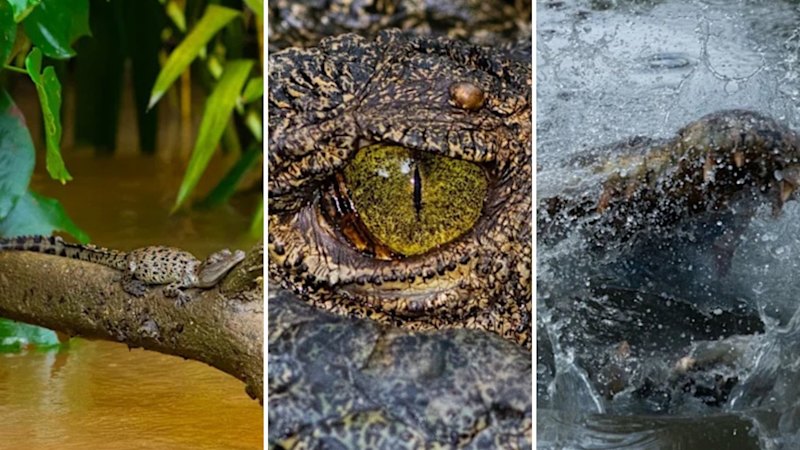If Gary Cranitch has learnt anything about photographing crocodiles, it’s that finding hatchlings is incredibly difficult.
The Proserpine River, which spills into the Pacific Ocean south of the tourist hotspot Airlie Beach, is home to the most condensed crocodile population in Queensland, but it wasn’t until Cranitch’s fifth trip there that he managed to get the shot he was looking for.
But once you’ve seen one, others tend to come out of the woodwork.
Hatchling crocodiles blend in to their habitat.Credit: Gary Cranitch, Queensland Museum
“I could see one or two hatchlings, and it wasn’t until I got back and took images off the card that I realised there were another eight or nine hatchlings in the image,” Cranitch says of the above photo while sitting at his desk in a backroom of the Queensland Museum.
“The camouflage is just so good you could not see them.”

The survival chances of crocodile hatchlings are quite slim. Credit: Gary Cranitch, Queensland Museum
He was elated to get the images, but admits it’s not work for the faint of heart. Where there are baby crocodiles there tends to be big crocodiles too.
“Mum’s around,” the photographer says with a slight grimace.
In a situation like that, Cranitch says the key is “making sure you’ve got enough boat beneath you, and [are] certainly not leaning over the sides”.
“There was always discussion of making sure your arms and legs are in the boat and making sure your footing on the boat [was solid] because you’re right among them,” he says.
The project was in the lead-up to the CROC! exhibition at the Queensland Museum. Credit: Gary Cranitch, Queensland Museum
The museum photographer’s quest for shots of hatchlings was part of an 18-month project snapping the world’s oldest predator around the state.
His remit was broad: get images for the museum’s upcoming exhibition on crocodiles (called CROC!) and expand the institution’s catalogue of crocodile photos.
And expand he did, taking thousands of photos of the apex predator both in captivity and the wild.
Saltwater crocodile teeth.Credit: Gary Cranitch, Queensland Museum
He started with animals in captivity at various enclosures and farms around north Queensland to get the proximity he knew he would need to get close-up images.
“I was building up this library of teeth,” Cranitch says.
He got a good reminder of what his subject was capable of during a feeding session at a crocodile farm near Rockhampton that takes in “problem crocodiles” relocated by the Queensland government.
Feeding time at the farm.Credit: Gary Cranitch, Queensland Museum
“He was showing me how fast a croc will launch out of the water,” Cranitch says.
“It was a sobering kind of thing to see that awesome power, and never to underestimate it. There are all sorts of warnings about being croc-safe in Queensland, and they ring true.”
Much of Cranitch’s usual works are landscapes taken from a small plane, and while he says this was a nice departure, some of the close-ups he has captured of crocodiles share a similarity with his aerial work in the unexpected patterning they reveal.
The eye of the crocodile. Credit: Gary Cranitch, Queensland Museum
It’s these close-ups that ended up playing a role in the exhibition, scattered subtly throughout as backdrops for three-dimensional exhibitions and features of interactive displays.
As he flicks through his huge catalogue of photos, Cranitch is unfussed that the images are not the main event.
“This exhibition will end, but the croc story keeps going,” he says.
Cranitch says the most common place to see a crocodile is on the river bend.Credit: Gary Cranitch, Queensland Museum
The exhibition, which focuses on the global story of crocodiles and features an impressive array of exhibits, will end, but not until October 2026. You can see it at the Queensland Museum at South Bank.
Start the day with a summary of the day’s most important and interesting stories, analysis and insights. Sign up for our Morning Edition newsletter.
Read the full article here


